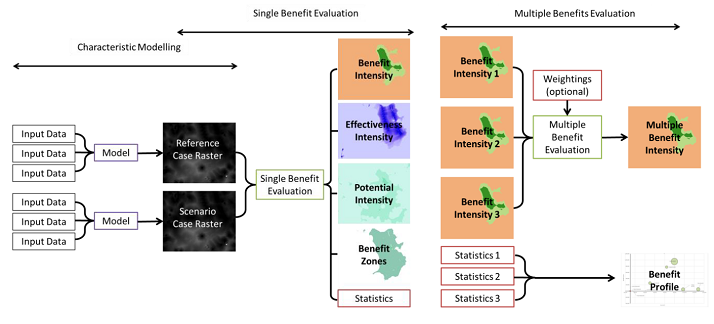Multiple Benefit Toolbox
The identification, evaluation and monetisation of the multiple benefits of Blue-Green infrastructrue may help reduce some of the barriers to the implementation of Blue-Green infrastructure to meet a range of policy objectives including flood risk management, city regeneration, environmental improvement and enhanced wellbeing and health.
As part of WP4, we have developed a methodology for the robust evaluation of the multiple functionalities of Blue-Green infrastructure which demonstrates the relative significance of benefits in context specific locations. This tool compliments CIRIA BeST (Benefits of SuDS Tool).
Downloads
April 2016: Multiple Benefits Toolbox. Zipped file containing ArcGIS Toolbox, 6.4 MB
Toolbox Guide  (PDF 690 KB) (release 1st February 2016)
(PDF 690 KB) (release 1st February 2016)
**please note that the tool is only compatible with OS topography data from December 2014 or earlier. This is because of an update to the OS Topography data format after the tool was drafted. The tool requires a 'Legend' column to characterise the landuse and this is absent from recent data. Data can be downloaded from the Edina Digimap website**
Multiple Benefits Toolbox
The Blue-Green Cities Multiple Benefits Toolbox was created in 2015 by Dr Malcolm Morgan at the University of Cambridge, Department of Engineering Centre for Sustainable Development, as part of WP4 research (Dick Fenner is the WP lead).
The tool was developed as a proof of concept to show that it is possible to assess the multiple benefits of Sustainable Urban Drainage Schemes (SuDS) in a manner that is spatial and context aware.
The benefit evaluation approach encompasses three principles:
- Normalisation – different types of benefit, such as a reduction in flood damage and increased access to greenspace, can be compared because they are normalised to a common scale.
- Spatial – the evaluation identifies where the benefits accrue and how the benefits are spatially distributed.
- Context sensitive – the benefit evaluation depends on the existing context of the location, thus the same intervention in two different locations may have different results.
The tool is provided ‘as is’ and will not be supported in the future. As the tool is a prototype it should not be used for actual design or planning decisions. This is due to the simplistic models used to calculate the spatial distribution of different characteristics; however, the benefit evaluation tools are functional, and could be used and developed further.
Required Software
The toolbox was developed for and requires ArcGIS 10.X with the Spatial Analysist add-on.
How the Multiple Benefits Toolbox works
The multiple benefit toolbox is divided into three stages:
- Characteristic Modelling
- Single Benefit Evaluation
- Multiple Benefit Evaluation
Characteristic Modelling takes some input data and creates a raster to present the spatial distribution of a physical characteristic of interest. For example, modelling the distribution of air pollution or noise. In each case the raster represents something that can be measured with appropriate units (e.g. µgm-3 or dB). Characteristic modelling should be done twice with different input data to reflect the Reference Case (e.g. before) and the Scenario Case (e.g. after).
Single Benefit Evaluation takes the output of the characteristic modelling and normalises the results onto a scale of 0-10. The normalisation process is unique to each characteristic and requires the setting of maximum and minimum values, and an equation that links the modelled characteristic to the normalisation process.
Finally, Multiple Benefit Evaluation takes the output from each single benefit evaluation and combines them in a weighted or unweighted way to identify the locations where different benefits co-exist.

Figure. Multiple Benefit Toolbox Flowchart showing Characteristic Modelling, Single Benefit Evaluation, and Multiple Benefit Evaluation